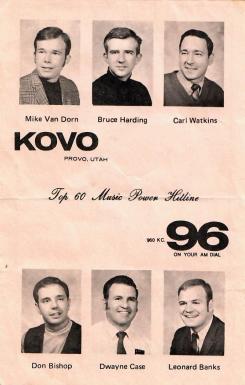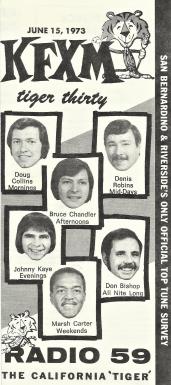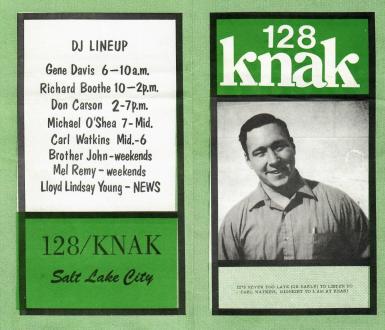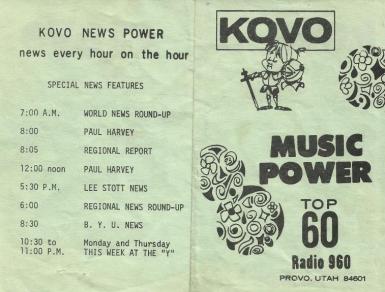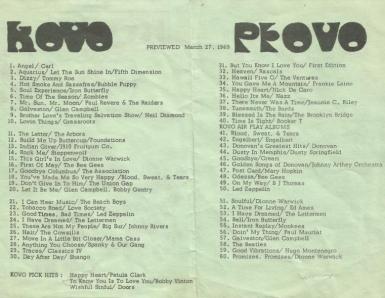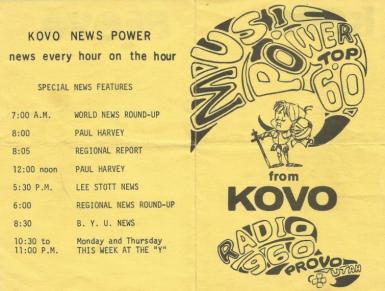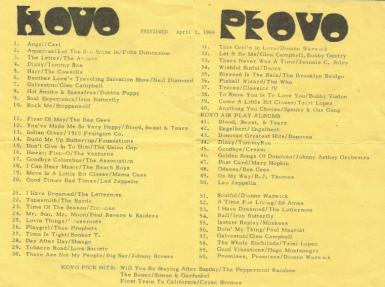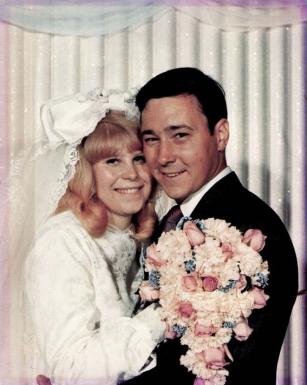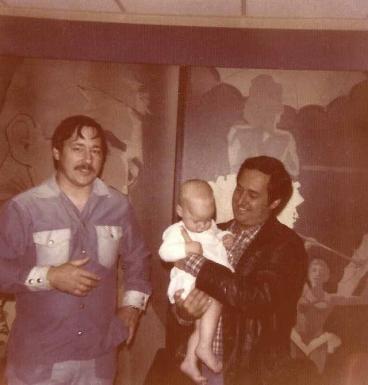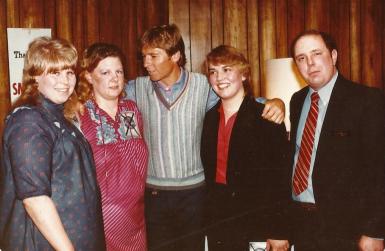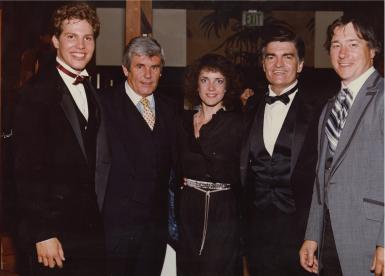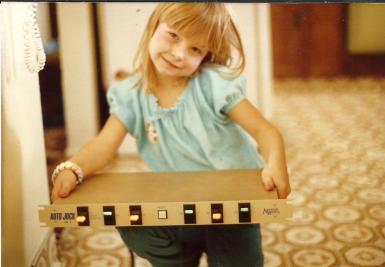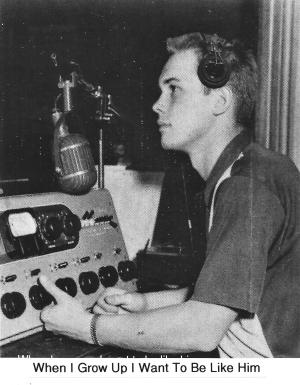The Revolving Door
My first job as a professional broadcaster was after my mission in the spring of 1968 at a small station - KBBC-1600 in Centerville, Utah playing "little old lady music. Then in December 1968, I finally became a pop music afternoon DJ at a small station - KIGO-1400 in St. Anthony, Idaho while attending nearby Ricks College. I recorded some of my early shows, which are painful for me to listen to today. But it was my starting place.
In mid-July 1969, Dwayne Case, the program director of KOVO-960 in Provo, Utah, hired me to work on the air. I was planning to also attend BYU in September. In those days we had to read the news during our program. One month later Dwayne laid me off (terminated me) because I was poor at reading news on the air. So on August 28, 1969, I began working at Signectics up on the Orem hill on University Parkway as an electronics technician. This is where I met a blond girl named Linda Ward, who was among over 100 single girls working there during my shift, and I was the only single guy. I thought she was the prettiest girl there. A year and a half later we were married. Thank you, Dwayne, for canning me! I never would have met Linda otherwise since she was not a radio groupie who called on the request line.
Back on the Radio - Working in Salt Lake City
In April 1970 President Nixon cut the defense spending which reduced business for Signetics. So I was laid off at Signetics, and I returned to KOVO-960 without the responsibility of reading the news. In early 1971, I began at KNAK-1280 in Salt Lake City 12M-6AM. So I was attending BYU in the day, dating Linda at night, and working at KNAK overnight. Sleep was rare and precious!
One time at KNAK-1280 at around 2:30AM, I fell asleep. After several minutes of dead air, two curious listeners pulled into the parking lot, looked through the studio window, and saw me laying on the floor. They banged on the glass, but I didn't move. They thought I had a heart attack. With all doors locked, one raced down the street to call the police on a pay phone while the other broke through the large glass window by the front door and found his way into the studio to save me! When Gene Davis arrived at 6:00 AM he asked me about the broken window. I told him there were some drunks in the parking lot. Later, when Richard Boothe, the program director, pressed me, I told the truth. He forgive me and even came to our wedding reception.
I married my sweet wife Linda on June 16, 1971 in the Salt Lake Temple, and we made our home in Provo where I began working for KEYY during the week and weekends at KCPX-1320 in Salt Lake City.
Over the next 16 years, I worked at KEYY in Provo, KCPX-1320 in Salt Lake, KSEE-1480 in Santa Maria, KFXM-590 in San Bernardino, KIMN-950 in Denver, KRIZ-1230 in Phoenix, KRUX-1360 in Phoenix, KYNO-1300 in Fresno, KPOK-1330 in Portland, KRSP-FM-103.5/1060 in Salt Lake, KWHO-FM-93.3 in Salt Lake, KCPX-1320, KEYY-1450, KSDO-FM-102.9 in San Diego, KLCY-94.1 in Salt Lake, KISN-97.1 in Salt Lake, KLTQ-93.3 in Salt Lake, KADQ-94.3 in Rexburg - and then KLCE-97.3 in Blackfoot from 1988 to 2003.
Returning to Salt Lake City - KRSP
In early 1976 I met Neil Sedaka backstage at a concert in Salt Lake City while working as Dr. Carl in the morning at KRSP-103.5/1060. Neil held David, our newborn baby boy. David is now our webpage designer and administrator for this website. And in 1983 while working at KLCY-94.1 in Salt Lake City, I, fellow DJ Don Bishop, and our wives met John Denver after his BYU Concert.
Return Again to Salt Lake City - KLCY
In 1982 I began working at KLCY-94.1 in Salt Lake City. We were changing from KALL-FM to KLCY (Classy) an adult contemporary station. I was on the air from 12:00 Noon to 3:00 PM. I also became the Master of Ceremonies for older musical groups performing at the Cherish Restaurant on South Temple Street just down the street from KLCY-94.1. Among the acts that we hosted were Gary Puckett, The Grass Roots, Bobby Vee, Blood, Sweat and Tears, Spankie and Our Gang, and Tony Bennett. A local group also performed composed of Paul Engemann, Jim Pike, Tammy Johnson, and Bobby Engemann. Jim and Bobby were original members of the Lettermen in the 60s. Paul was Bobby's nephew. They were forming a new group called Star. But Star was short-lived as they formed Runion shortly thereafter composed of Jim, Bobby, and Ric de Azevedo, the brother of Lex de Azevedo. Here is a picture of Star with me on the right.
I have worked at a lot of stations in different towns climbing the radio ladder over the years. I got fired at some and quit at others for a better job. It reminds me of a funny line attributed to Charlie Tuna: “Do you know how you can tell how long a disc jockey has been in the business? — by the size of his U-Haul.” How true! We could see that our family life wasn't a stable one like the ones we had growing up. We longed to find a good station in a good town that believed in long-term goals, even if it wasn't the highest paying job — so our kids could all grow up in the same town and graduate from the same high school. Well, that finally happened at KLCE-97.3 in Blackfoot, Idaho.
Engineer
Throughout my broadcast career, using my electronics background, I doubled as the chief engineer at several of the radio stations where I was employed. In 1984 it became popular for stations in smaller radio markets to join radio music networks. They sounded local, but in reality, their music originated from studios far away, such as in Los Angeles, New York, Dallas, Colorado, and Chicago. All programming came from the network except for the local commercials which were inserted by the local stations. One such network was Satellite Music Network in Chicago. With no local DJs and other studio personnel, the local stations were able to deliver quality programming very inexpensively. So I saw the need to develop a relatively inexpensive piece of equipment to facilitate this operation. Thus, the "Auto-Jock" was born, which interfaced the satellite network with the station tape players to automatically play commercials and/or news within the selected breaks throughout the hour. From 1986 to around 1994, I designed, constructed, marketed, and sold around 15 Auto-Jocks to stations around the country. Here is my 9-year-old daughter Cristy holding one of my Auto-Jocks in 1989.
As a grown woman, Cristy's voice is now heard regularly on Sounds of Sunday, including the woman's voice on CTR Clothing spots.
Stability in East Idaho
In 1988, seventeen years after we were married and after our 7th child was born, we moved to Blackfoot, Idaho where I worked both as a DJ and chief engineer for a good man at a great group of radio stations. I was also happy to be back in Blackfoot as I had served there as a missionary in 1967.
When the stations were sold for the 3rd time in December 2003, my employment there ended. With our oldest 5 children moved out, Michael on a mission, and Shawn a junior in high school, we remained in Blackfoot, and I converted our downstairs den into a recording studio. I spent most of my time producing a syndicated version of Sounds of Sunday for up to 17 radio stations in Idaho, Wyoming, Utah, and Arizona, and for the internet station Sounds of Sunday (24/7). Listen on Alexa, Google Home, Apple Homepod, or by using the TuneIn App on computers, cellphones, tablets, and Ruku devices. Our sponsors compensate us for our expenses.
Provo, Utah
In August 2018, we moved to Provo, Utah to be near 5 of our kids and their families, and my mother Verda who turned 104 in May 2021, all living in Utah County. Our smallest bedroom is now my new studio. It's smaller, but it's adequate.
I am doing something I have always wanted — consecrating my broadcast experience to inspire listeners everywhere to have faith in Jesus Christ through some of the most wonderful music and messages to be heard. I receive some great emails from listeners that encourage me. It’s impossible to know all the good that results from the show, but I hope to continue serving God in this way to make the world a better place. What better thing could I hope to do in my retirement? Retirement? - what’s that?

